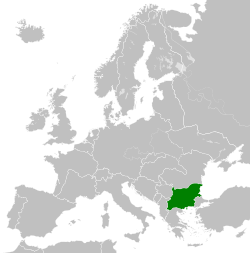
Back مملكة بلغاريا Arabic Reinu de Bulgaria AST Bolqarıstan çarlığı Azerbaijani بولغاریستان کراللیغی AZB Өсөнсө Болгар батшалығы Bashkir Трэцяе Балгарскае царства Byelorussian Царство България Bulgarian Regne de Bulgària Catalan Bulharské carství Czech Kongeriget Bulgarien Danish
This article needs additional citations for verification. (February 2023) |
Tsardom of Bulgaria Царство България Tsarstvo Bǎlgariya | |||||||||||||
|---|---|---|---|---|---|---|---|---|---|---|---|---|---|
| 1908–1946 | |||||||||||||
| Motto: Съединението прави силата Saedinenieto pravi silata ("Unity makes strength") | |||||||||||||
| Anthem: Шуми Марица Shumi Maritsa Maritsa Rushes (1886–1946) Royal anthem: Химн на Негово Величество Царя Himn na Negovo Velichestvo Tsarya ("Anthem of His Majesty the Tsar") | |||||||||||||
 The Kingdom of Bulgaria in 1942 | |||||||||||||
 Administrative divisions of the Kingdom of Bulgaria in 1942 | |||||||||||||
| Capital and largest city | Sofia | ||||||||||||
| Official languages | Bulgarian | ||||||||||||
| Religion | Bulgarian Orthodox Church (state religion)[1] | ||||||||||||
| Demonym(s) | Bulgarian | ||||||||||||
| Government | Unitary parliamentary constitutional monarchy (1908–1935; 1943–1946)
(1935–1943) (de facto) | ||||||||||||
| Tsar (King) | |||||||||||||
• 1908–1918 | Ferdinand | ||||||||||||
• 1918–1943 | Boris III | ||||||||||||
• 1943–1946 | Simeon II | ||||||||||||
| Chairman of the Council of Ministers | |||||||||||||
• 1908–1911 (first) | Aleksandar Malinov | ||||||||||||
• 1944–1946 (last) | Kimon Georgiev | ||||||||||||
| Legislature | National Assembly | ||||||||||||
| Historical era | Balkan Wars • World War I • Interwar period • World War II | ||||||||||||
| 5 October 1908 | |||||||||||||
| 1912–1913 | |||||||||||||
| 10 August 1913 | |||||||||||||
| 1915–1918 | |||||||||||||
| 27 November 1919 | |||||||||||||
| 9 June 1923 | |||||||||||||
| 19 May 1934 | |||||||||||||
• Counter-coup by Boris III | 1935 | ||||||||||||
| 7 September 1940 | |||||||||||||
| 9 September 1944 | |||||||||||||
| 15 September 1946 | |||||||||||||
| Area | |||||||||||||
| 1915 | 122,134 km2 (47,156 sq mi) | ||||||||||||
| Population | |||||||||||||
• 1915[2] | 4,580,000 | ||||||||||||
| Currency | lev | ||||||||||||
| ISO 3166 code | BG | ||||||||||||
| |||||||||||||
| Today part of | Bulgaria | ||||||||||||
The Tsardom of Bulgaria (Bulgarian: Царство България, romanized: Tsarstvo Bǎlgariya), also referred to as the Third Bulgarian Tsardom (Bulgarian: Трето Българско Царство, romanized: Treto Balgarsko Tsarstvo), sometimes translated in English as the "Kingdom of Bulgaria", or simply Bulgaria, was a constitutional monarchy in Southeastern Europe, which was established on 5 October (O.S. 22 September) 1908, when the Bulgarian state was raised from a principality to a tsardom.[3]
Ferdinand, founder of the royal family, was crowned a Tsar at the Declaration of Independence, mainly because of his military plans and for seeking options for unification of all lands in the Balkans region with an ethnic Bulgarian majority (lands that had been seized from Bulgaria and given to the Ottoman Empire in the Treaty of Berlin).
The state was almost constantly at war throughout its existence, lending to its nickname as "the Balkan Prussia". For several years Bulgaria mobilized an army of more than 1 million people from its population of about 5 million, and in the 1910s it engaged in three wars – the First and Second Balkan Wars, and the First World War. Following the First World War the Bulgarian army was disbanded and forbidden to exist by the Allied Powers, and all plans for national unification of the Bulgarian lands failed.
Less than two decades later Bulgaria entered the Second World War on the side of the Axis Powers and once again found itself on the losing side, until it switched sides to the Allies in September 1944. In 1946, the monarchy was abolished, its final Tsar was sent into exile, and the Tsardom was replaced by the People's Republic of Bulgaria.
- ^ J. Havighurs, Robert (2005). The Constitutions of the States at War, 1914–1918. Harvard University Press. p. 91. ISBN 978-0822974079.
The Orthodox Christian Religion of the Eastern Rite is the State religion of the Kingdom of Bulgaria
- ^ "Central Powers – Kingdom of Bulgaria". p. 4. Retrieved 14 Jan 2022.
- ^ "Bulgaria at the end of the 19th-century". Encyclopedia Britannica. Retrieved 2021-07-01.
© MMXXIII Rich X Search. We shall prevail. All rights reserved. Rich X Search

